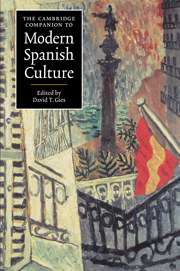Book contents
- Frontmatter
- Modern Spanish culture
- I Culture
- II Culture and history
- III Culture and prose
- 8 Narrative in culture, 1868-1936
- 9 Narrative in culture, 1936-1975
- 10 Narrative in culture, 1975-1996
- 11 Culture and the essay in modern Spain
- IV Culture and poetry
- V Culture and theater
- VI Culture and the arts
- VII Media
- Index
- Series List
9 - Narrative in culture, 1936-1975
from III - Culture and prose
Published online by Cambridge University Press: 28 May 2006
- Frontmatter
- Modern Spanish culture
- I Culture
- II Culture and history
- III Culture and prose
- 8 Narrative in culture, 1868-1936
- 9 Narrative in culture, 1936-1975
- 10 Narrative in culture, 1975-1996
- 11 Culture and the essay in modern Spain
- IV Culture and poetry
- V Culture and theater
- VI Culture and the arts
- VII Media
- Index
- Series List
Summary
The Spanish Civil War and Franco's dictatorship were pervasive in the cultural life of Spain from the start of the armed conflict on 18 July 1936 until the Generalísimo's death on 20 November 1975. With a country divided into two irreconcilable factions, most individuals had to choose a side, willingly or not, and their private plans or desires seldom coincided with the events that engulfed them. Any cultural object, be it a novel, a movie, or a daily column in a newspaper, was scrutinized for its political impact by special governmental, political, and religious organizations which existed solely to multiply the rules that creators and producers had to obey and to reinforce the limits of transgression. If one takes into account this restricted field of operations and its consequences, the narrative of this period reveals itself as daring, experimental, and accomplished.
A novel that appeared in the first year of the war, Cinematógrafo (1936) by Andrés Carranque de Ríos, is a reminder that several creative strains in Spanish culture were drastically interrupted by the insurrection. Carranque, besides being a writer, was an actor in several movies who sympathized with anarchism. He draws a funny and scathing portrait of the primitive Spanish film industry. His main characters are exploited, frustrated by poverty and physical limitations, but manage to see beyond their private suffering and to act for the larger social and political good. Carranque's novel presents a contrast to the dreamy and Utopian novels published in the anarchist series La novela ideal (The Ideal Novel) and La novela libre (The Free Novel) that for thirteen years, until interrupted by the war, churned out almost 600 titles with runs of between 10,000 and 50,000 copies.
- Type
- Chapter
- Information
- The Cambridge Companion to Modern Spanish Culture , pp. 134 - 146Publisher: Cambridge University PressPrint publication year: 1999



